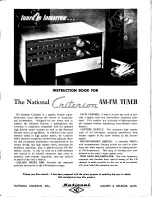
LD900 Installation
LD900 Installation and Oper ations M anual
29
Terminated Tails of LMR240
When running multiple coaxial cables, VERIPOS recommends labelling to ensure cables are attached to the
correct antennas and equipment.
Survey the route of the antenna cabling to ensure:
•
The total length of the cable run d oes not exceed the supplied cable length for this installation. Contact
your supplier or
if this is not the case.
•
The cable does not cross or run parallel with any
single-phase or three-phase power cables
(110
VAC, 220 VAC or 440 VAC) or any high-power RF cables leading to transmitting devices such as
Inmarsat and VSAT domes.
•
The cable
avoids proximity to fluorescent lighting and wiring
.
•
The cable is not placed under tension. A
support wire
is used where the cable run has to cross a free
space and does not rely solely on cable ties for support.
•
Suf ficient space is available in the selected cable entry through the bulkhead for the connectors to pass
through without damage. If the connector cannot pass through the cable entry it may be necessary to
cut the connector off and re-terminate once the cable has been passed through.
•
The cable is
not pinched
.
•
The route is
free from all burrs or sharp edges
that could cut the cable jacket over time and lead to
water ingress.
•
All
connectors and couplers are completely sealed
from the environment with overlapping layers of
self -amalgamating tape and finished with layers of electrical tape or Scotchkote.
•
Stress loops
are f itted to prevent excess force on the connectors, in particular on the antenna
connectors.
•
The
minimum bend radius
for the cable is not exceeded.
Typical cable installation in a bridge mast area
















































